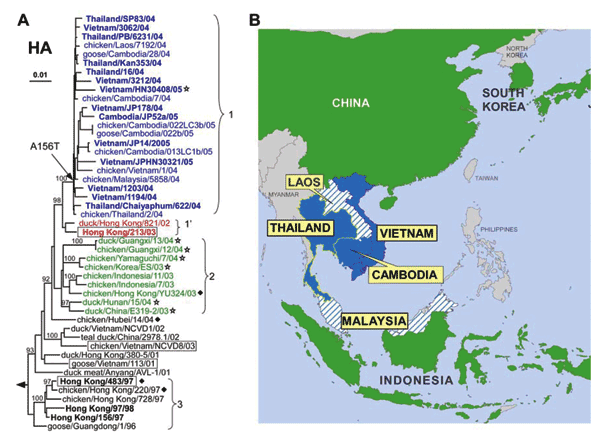Volume 11, Number 10—October 2005
Research
Evolution of H5N1 Avian Influenza Viruses in Asia
Figure 1

Figure 1. Phylogenetic relationships among H5 hemagglutinin (HA) genes from H5N1 avian influenza viruses and their geographic distribution. Viral isolates collected before and during the 2004–2005 outbreak in Asia and selected ancestors were included in the analysis (Table A1). HA clades 1, 1′, and 2, discussed in the text, are colored in blue, red, and green fonts, respectively. Virus names in boldface denote isolates from human infections. Phylogenetic trees were inferred from nucleotide sequences by the neighbor-joining method with A/chicken/Scotland/56 genes as outgroup (not shown, denoted by arrowhead). Bootstrap analysis values >90% are shown. A) HA gene tree phylogeny was based on the coding region of the segment. Presence of a motif for glycosylation in HA is indicated as A156T by an arrow at the root of clade 1 and a diamond for other clades (Table 1). Stars denote absence of 1 arginine residue at the polybasic cleavage site, which starts at position 325 of HA1. Isolates to which ferret antisera were made for antigenic analyses are boxed (Table 2). B) Geographic distribution of H5N1 in east Asia: blue denotes countries reporting infections with clade 1 H5N1 in humans and birds (solid) or in birds only (hatched). Green denotes countries reporting bird infections with clade 2 H5N1 viruses.
1Members of the World Health Organization Global Influenza Program and collaborating laboratories: Jean-Thierry Aubin, Saliha Azebi, Amanda Balish, Jill Banks, Niranjan Bhat, Rick A. Bright, Ian Brown, Philippe Buchy, Ana-Maria Burguiere, Hua-lan Chen, Peter Cheng, Nancy J. Cox, Alice Crosier, Aaron Curns, Frédérique Cuvelier, Guohua Deng, Julia Desheva, Stéphanie Desvaux, Nguyen Hong Diep, Ruben O. Donis, Alan Douglas, Scott F. Dowell, Nguyen Tien Dung, Lindsay Edwards, Keiji Fukuda, Rebecca Garten, Elena Govorkova, Victoria Gregory, Alan Hampson, Nguyen Thi Hong Hanh, Scott Harper, Alan Hay, Erich Hoffmann, Diane Hulse, Masaki Imai, Shigeyuki Itamura, Samadhan Jadhao, Patricia Jeannin, Chun Kang, Jackie Katz, Jae-Hong Kim, Alexander Klimov, Yong-kuk Kwon, Chang-Won Lee, Phuong Song Lien, Yanbing Li, Wilina Lim, Yi Pu Lin, Stephen Lindstom, LaMorris Loftin, Jan Mabry, Le Quynh Mai, Taronna Maines, Jean-Claude Manuguerra, Masaji Mase, Yumi Matsuoka, Margaret McCarron, Marie-Jo Medina, Doan Nguyen, Ai Ninomiya, Masatsugu Obuchi, Takato Odagiri, Malik Peiris, Michael L. Perdue, Jean-Marc Reynes, James Robertson, Claudine Rousseaux, Takehiko Saito, Somchai Sangkitporn, Michael Shaw, James M. Simmerman, M. Slomka, Catherine Smith, San Sorn, Erica Spackman, Klaus Stöhr, David L. Suarez, Haan Woo Sung, David E Swayne, Maryse Tardy-Panit, Masato Tashiro, Pranee Thawatsupha, Terrence Tumpey, Timothy Uyeki, Phan Van Tu, Sylvie van der Werf, Sirenda Vong, Richard Webby, Robert Webster, John Wood, Xiyan Xu, Guan Yi, and Wenqing Zhang. For author affiliations, please Download PDF (37 KB, 2 pages).